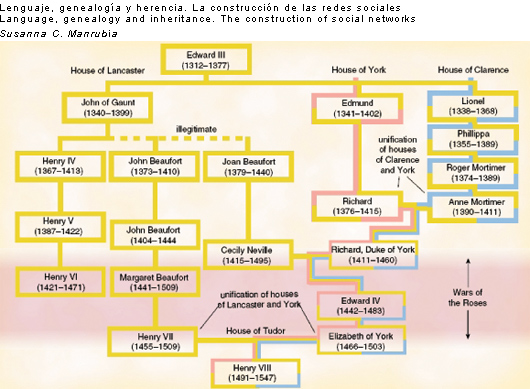
Language, genealogy and inheritance. The construction of social networks
Carlos Briones, Susanna C. Manrubia y José Ángel Martín-Gago
Astrobiology Centre (CSIC-INTA), Madrid
(Excerpt from Atrapados en la red: nanomundo, vida sociedad)
In one of its countless branching events, the evolutionary process had certain multicellular eukaryotes turn into animals, and then some primates develop their brains enormously. Evolution made us human. Nowadays, social beings that we are, when we think of our relational networks we tend to overemphasize the significance of a (contingent) history, family inheritance, our memory. But the behaviour of large groups is ruled by statistical principles, not by personal volition. There are forces among us that pull us toward or away from others, that make us prefer one group to another. At times, our personalities vanish and we seem to have become a group of social insects rather than a society of distinct individuals. Perhaps we are but particles sustaining interactions, photons that interweave their existence to that of others and partake in a relational network encompassing all of mankind, a network whose reach we would recognise were we not this short-sighted. When we define our being in the world by the immediacy of the here and now we narrow our perspective. Our own relational dynamics dictate who is or is not in our neighbouring nodes, and conditions the building of circuits which, from a bird’s eye view, traverse all of society. Percolate through it. On certain occasions, the plan of a city is but a surface covered in atoms in which the network is defined by their absence. Just like the nanoworld constructed the chemical universe with the aid of the fundamental forces, a universe that set the principles which allowed the evolution of life and of complex brains, and the latter are the foundation that makes society and culture possible, so we must imagine higher levels of organisation that transcend us and in which we are the equivalent of those simple RNA molecules that travel within a boundless space of sequences subjected to the currents of evolution.
At the foundation of our social being, of our being trapped within a network, is our cultural and biological baggage. It is an enormous amount of inherited information that links us to each and every other human being in this dense world. We are the children of two individuals of different sexes. One gave us our surname, the other our mitochondria; both passed on their nuclear genes, intimately entwined, and their language. What we brandish as our individuality is in fact the complex articulation of what has been given us, and their expression within an environment that conditions us in a thousand imperceptible ways. We are beings in context, inextricable nodes in the network of humanity.
Our inheritance is visible in our genealogies, among other things. We have two parents, four grandparents, eight great-grandparents, and so on, in an explosion of individuals that lived in the past and who have bequeathed to us part of their genomes, as shown in the family tree (figure 3). This is our local version of the tree of life, the one that eventually links us to fungi, plants, bacteria, and every other living being. The surname or the language that we speak, two features to which we tend to feel overly attached, are but a minute fraction of what we accumulate constructively. If we go back but two hundred years in our family tree, the number of our ancestors increases to about a thousand individuals. Probably all of them contributed to our genome. Only one contributed to our surname.
The situation becomes paradoxical if we continue to look back. A hundred thousand years ago, between ten and a hundred thousand modern humans populated the Earth. Our family tree, then, should show an inexpressible number of individuals: one followed by about fourteen hundred zeroes. But only the humans who existed at that time can be part of the family tree. There is a simple solution to the riddle. As we go back in our tree, the frequency of individuals who are repeated increases: we all know examples of more or less distant relatives who have married among themselves. This is the source of the repetitions, and also an evident example of how society builds its networks… and how the networks in turn shape society. The similarities among the family trees of any two individuals chosen at random increase as we go back in time. We do not need to go far. Let us picture a population of a thousand individuals in which couplings occur randomly and whose size has remained more or less constant through time. It only takes eighteen generations for the family trees of every individual to be identical, a point in which an ancestral population appears (about 80% of the total) who are the forebears of all of the present individuals. In a population of size N of the above characteristics it takes an average time of about 1.77 log N to find the first common ancestor of two randomly chosen individuals. And the leap from the first common ancestor in two family trees to a full match happens in about fourteen generations, regardless of population size. This is too short a time to assert that our differences are due to inheritance.
Geographic isolation, much more common in preceding centuries than in our globalised present, has fostered diversity among humans. Those populations that remained isolated the longest have cultural features farther from the average than other populations that have sustained regular exchanges. Linguistic diversity is the clearest example of how the sole factor of geographical barriers that constrain mobility can lead to the emergence of multiple detached communities as far as language is concerned. On the other hand, the effect of such barriers disappears as soon as regular relations are established between two groups that differ in their languages. The more than 500 languages spoken in Papua New Guinea are an example of the first situation; the development of the Creole dialects in the span of a few generations out of a need to establish trade contacts, and the loss of grammatical complexity that it entails, is an instance of the second. Our world has experienced an irreversible transition toward homogeneity with the development of means of transport and the global information network. The population flows, the ease with which we travel long distances, the increasing probability of living in several different places far from each other, and the mingling of cultures involved in all of the above have changed the structure of the cultural and linguistic inheritance process. In the European farming societies of the past few centuries, the typical distance between the original residences of a husband and a wife ranged between 5 and 10 kilometres. At present, this distance is much larger. Worldwide population flows, which do nothing but increase, configure a new social structure. Languages are lost irreparably, and their transmission is no longer ruled by parent-child inheritance, but by a socio-cultural engine that pushes individuals to move in search of a life that may not be better, but is certainly more Westernised. And plugged into the net (…)
Figure 3: The family tree of Henry VIII or the social network of his ancestors? Repetitions in genealogy are common not only in small populations (such as aristocracy, which consists of individuals historically bound to marry others in their own class) but in any population as long as we go far back enough in time [Figure extracted from the article “Genealogy in the Era of Genomics” by S. C. Manrubia, B. Derrida and D. Zanette published in American Scientist 91, 158-165 (2003)].

